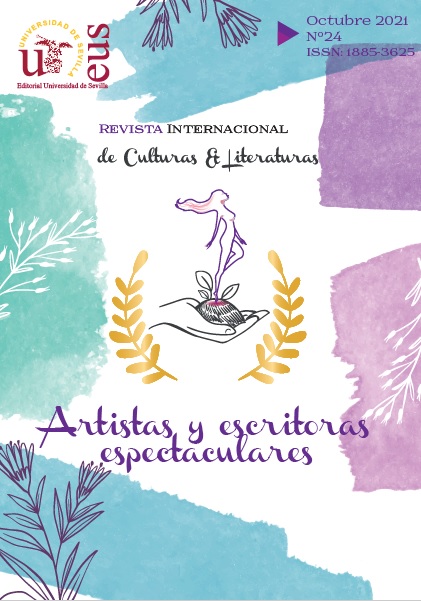REESCRITURA DEL MITO Y REPRESENTACIÓN DE LO FEMENINO EN LA NOVELA LES PRÉNOMS ÉPICÈNES (2018) DE AMÉLIE NOTHOMB
DOI:
https://doi.org/10.12795/RICL2021.i24.01Keywords:
mito, intertextualidad, estereotipos, postmodernoAbstract
The contribution analyzes the way Amélie Nothomb re-uses different forms of (literary as well as cultural) myths to in her novelLes prénoms épicènes (2018) through a process of deconstruction and re-combination of their constitutive elements. The intertextual relation to the Elizabethan comedy Epicoene (1609) and to the myth of Orpheus are used to ironically point at the many clichés related to female roles.
Downloads
Metrics
References
Jonson, Ben (1976). Epicœne or the silent woman (1609), ed. R. Holdsworth. Bloomsbury.
Nothomb, Amélie (1992). Hygiène de l'assassin. Albin Michel.
Nothomb, Amélie (1995). Les Catilinaires. Albin Michel.
Nothomb, Amélie (2003). Attentat. Albin Michel.
Nothomb, Amélie (2008). Le fait du prince. Albin Michel.
Nothomb, Amélie (2014). Pétronille. Albin Michel.
Nothomb, Amélie (2017). Frappe-toi le cœur. Albin Michel.
Nothomb, Amélie (2018). Les prénoms épicènes. Albin Michel.
Amanieux, Laureline (2002). La présence de Dionysos dans l’oeuvre d’Amélie Nothomb. Réligiologiques, 25, 131-146.
Amanieux, Laureline (2009). Le récit siamois. Identité et personnage dans l’œuvre d’Amélie Nothomb. Albin Michel.
Béague, Annick, Boulogne, Jacques, Deremetz, Alain, y Toulze, Françoise (1998). Les visages d’ Orphée. Presses universitaires du Septentrion, 1998.
Benali, Souad (2009). Le personnage féminin en difficulté. Cas d’étude: les romans de Amélie Nothomb. Les cahiers du CRASC, 20, 41-52.
http://cahiers.crasc.dz/pdfs/n_20_benali.pdf
Bouloumié, Arlette (2004, Enero). La résurgence du mythe d’Eurydice et ses métamorphoses dans l’oeuvre d’Anouilh, de Pascal Quignard, de Henri Bosco, de Marguerite Yourcenar, de Michèle Sarde, et de Jean-Loup Trassard. Loxias - Revue des centres de recherche pluridisciplinaires, 2.
http://revel.unice.fr/loxias/document.html?id=1244
Constant, Isabelle (2003). Construction hypertextuelle: “Attentat” d’Amélie Nothomb. The French Review, 76(5), 933-940. http://www.jstor.org/stable/3133231
Dewez, Nausicaa (2003). L’Immortalité par la mort. Le mythe d’Orphée dans l’œuvre d’Amélie Nothomb. Lettres romanes, 57(1-2), 127-138. DOI: 10.1484/J.LLR.3.70
Helm, Yolande (1996). Amélie Nothomb: l’ «enfant terrible» des lettres belges de langue française. Études francophones, 11(1), 113-120.
Helm, Yolande (1997). Amélie Nothomb: une écriture alimentée à la source de l’orphisme. Réligiologiques, 15, 151-163.
Heurgon, Jacques (1932). Orphée et Eurydice avant Virgile. Mélanges d’archéologie et d’histoire, 49(1), 6-60.
Kushner, Eva (1961). Le mythe d’Orphée dans la littérature française contemporaine. A. G. Nizet.
Marois, Laurence (2011). Le double mythique : la figure d’Eurydice dans Mercure d’Amélie Nothomb. Revista de mitocritica, 3, 73-93. DOI: 10.1891/0886-6708.5.2.119
Oberhuber, Andrea (2004). Réécrire à l’ère du soupçon insidieux: Amélie Nothomb et le récit postmodeme. Études françaises, 40(1), 111-128. DOI: 10.7202/008479ar
Ribarova, Pavlina (2013). Dimensions mythologiques des romans d’A. Nothomb: Mythifier, demythifier et remythifier. Bulgaria Research Papers, 51(1), 193-205.
Published
How to Cite
Issue
Section
Accepted 2021-09-10
Published 2021-10-08
- Abstract 295
- PDF (Español (España)) 228
- HTML (Español (España)) 24




